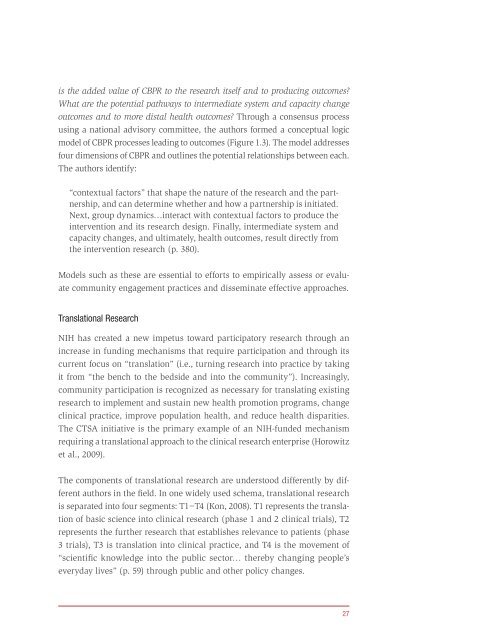Principles of Community Engagement (Second Edition)
Principles of Community Engagement (Second Edition)
Principles of Community Engagement (Second Edition)
You also want an ePaper? Increase the reach of your titles
YUMPU automatically turns print PDFs into web optimized ePapers that Google loves.
is the added value <strong>of</strong> CBPR to the research itself and to producing outcomes?<br />
What are the potential pathways to intermediate system and capacity change<br />
outcomes and to more distal health outcomes? Through a consensus process<br />
using a national advisory committee, the authors formed a conceptual logic<br />
model <strong>of</strong> CBPR processes leading to outcomes (Figure 1 3) The model addresses<br />
four dimensions <strong>of</strong> CBPR and outlines the potential relationships between each<br />
The authors identify:<br />
“contextual factors” that shape the nature <strong>of</strong> the research and the partnership,<br />
and can determine whether and how a partnership is initiated<br />
Next, group dynamics…interact with contextual factors to produce the<br />
intervention and its research design Finally, intermediate system and<br />
capacity changes, and ultimately, health outcomes, result directly from<br />
the intervention research (p 380)<br />
Models such as these are essential to efforts to empirically assess or evaluate<br />
community engagement practices and disseminate effective approaches<br />
Translational Research<br />
NIH has created a new impetus toward participatory research through an<br />
increase in funding mechanisms that require participation and through its<br />
current focus on “translation” (i e , turning research into practice by taking<br />
it from “the bench to the bedside and into the community”) Increasingly,<br />
community participation is recognized as necessary for translating existing<br />
research to implement and sustain new health promotion programs, change<br />
clinical practice, improve population health, and reduce health disparities<br />
The CTSA initiative is the primary example <strong>of</strong> an NIH-funded mechanism<br />
requiring a translational approach to the clinical research enterprise (Horowitz<br />
et al , 2009)<br />
The components <strong>of</strong> translational research are understood differently by different<br />
authors in the field In one widely used schema, translational research<br />
is separated into four segments: T1−T4 (Kon, 2008) T1 represents the translation<br />
<strong>of</strong> basic science into clinical research (phase 1 and 2 clinical trials), T2<br />
represents the further research that establishes relevance to patients (phase<br />
3 trials), T3 is translation into clinical practice, and T4 is the movement <strong>of</strong><br />
“scientific knowledge into the public sector… thereby changing people’s<br />
everyday lives” (p 59) through public and other policy changes<br />
27

















